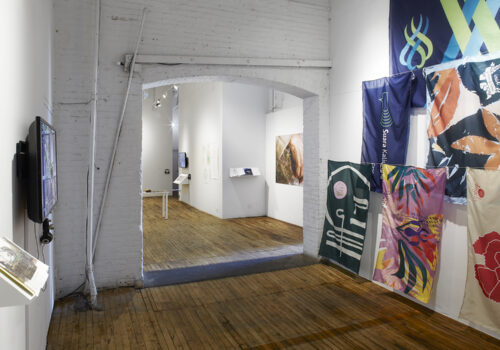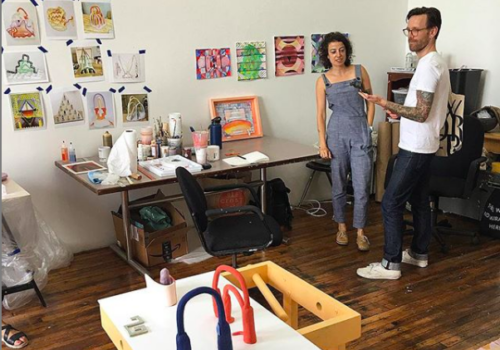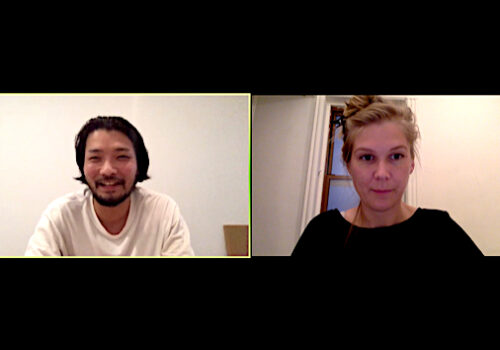Kari Conte: Firstly, what is LIR Space? Dito Yuwono: Now it can be anything. Mira Asriningtyas: It is an art space. It was a physical art space, but now it can be anything. It’s a movable institution. D: Yes, I agree. K: Can you speak about past LIR projects? How has the programming evolved into what it is today? D: LIR started with space in 2011—a physical space—which at first focused on young artists, and then on alternative education. In 2017, we started a project called 900mdpl, which is a site-specific project in Kaliurang, Indonesia. And in 2019, we decided to close our physical space and make the institution nomadic rather than a permanent institution, after that we continued with the second edition of 900mdpl. K: You mentioned that you focus on alternative education, meaning outside of the academy. What does this specifically mean for you in the Indonesian context? What is the lack you perceive in traditional Indonesian art education that motivated you to create a platform for alternative education? M: What we see lacking in the education system is the space for experimentation by young artists, to work with other disciplines, rather than just art. D: Especially in our context, it doesn’t make sense if you are talking about art only from the established art scene, it doesn’t make sense because everything collides together. At the same time, there’s a strong political movement, as well as many social problems. Maybe that is why people across disciplines come together to achieve one common goal. K: You mentioned that your programming is supported by “social exchange” more so than monetary budgets. Can you elaborate on what this social exchange is, and do you see your programs continuing primarily with that kind of support structure? M: All staff is paid, that’s number one. But then there are other social structures and alternative exchanges, not unique to LIR but which are present in many art spaces in Indonesia, which you can read more about here. D: This kind of exchange is part of the social art world in Indonesia. Without solid support from the government, we try to find solutions together with the community, from the bottom up. In the case of Kaliurang and the context of 900mdpl, one of the examples of how we give back to the residents who are generous with their time and energy is to help them build a structure to attract new kinds of tourists. Together, we developed a tour of colonial architecture, and then we brought together artists to do some fieldwork and research on the buildings. We shared this research with the Kaliurang community for them to use as part of their tourism initiatives. M: We also developed an alternative education program at LIR Space together with senior artists for younger artists called Ex.Lab. This platform ran for two years and it was based on how we (LIR and senior artists) share the same concern for artist education. So, the senior artist usually taught voluntarily. K: Let’s talk about 900mdpl. It’s a project you initiated in Kaliurang, you’re working towards your third edition next year, and you’ve translated the last two editions into the exhibition at ISCP. In short, the exhibition consists of site-specific works that you commissioned about Kaliurang, which is an active volcano town. 900mdpl preserves the historical knowledge of the town and transient generational knowledge, memory. You’ve talked a lot about the artists conducting research based on the villager’s storytelling. But you haven’t spoken about the textual archive or textual resources for the artists that come to do the projects. Is the written archive something that doesn’t exist or is it because the artists are more interested in developing their projects through oral histories? M: When the artists first start their project, we give them a pack of books. We have a package of many writings, for example, books on the volcano, anthropology, on history, or even children’s books about mythology. These ones are usually for the Indonesian artists, because many of the books are in Indonesian. So, the artists already know and have an idea of the village before the residency. But we are also working on new texts in English to be added to the 900mdpl reader that we publish after each edition. D: The project itself aims to preserve knowledge, and it is also important that we produce something that is physical, which is the book, and this arises from the people’s stories. So, these people, these oral histories were documented and materialized into book form for 900mdpl. This is why we are interested in publishing, and not only reading existing books. M: Every year there will be new writing on the art commissioned for 900mdpl as well writing on alternative histories of Kaliurang. K: The third edition will be about how the town’s own mythology preserves the ecological conditions, or I imagine the lack of environmental degradation. Can you speak about how you envision the next edition? M: The starting point is the exhibition’s site. The first edition was presented around the village area, the second edition was located around the colonial building areas, and the third will be near critical or sacred areas such as water sources and the forest, places at risk for mining and gentrification. We will work closely with the local traditional community, who have many rituals to preserve nature and we will work with local wisdoms or mythologies circulating among the people of Kaliurang. We’ll start from this and we’ll then invite international contemporary artists to give different perspectives. K: You mentioned that there are fifty art spaces in Yogyakarta, and one of your aims for LIR is that of institutional renewal. LIR transforms according to what is needed by its community, and you’ve been in New York for the last three weeks, which has a robust art scene. Has your research here led you to new ideas that you can take back to LIR and your own community? D: Actually, the context is completely different. It is too bad that we couldn’t visit some underground art spaces. K: We don’t have many. D: I think we can learn something from that kind of institution, rather than large ones. In Yogyakarta, we don’t have the structure for larger institutions. But maybe the most impressive thing for me has been the independent bookshops here, in terms of self-publishing. K: Did you visit Printed Matter? D: Yes, we visited Printed Matter and Bluestockings among others, these two were amazing. K: Does Indonesia have a contemporary book fair? D: Someone is trying to make one. K: What’s next? M: We are working on new projects with platforms we never tried before. It’s still off the record but follow us through our Instagram @lirspace to get updates!]]>
Now it Can Be Anything: Mira Asriningtyas and Dito Yuwono in conversation with Kari Conte

April 03, 2020
by Kari Conte
Summer Residencies for Art Faculty

April 20, 2020
by Alexandra Sloan Friedman
The International Studio & Curatorial Program is New York’s most comprehensive international visual arts residency program. ISCP is perhaps best known for the nearly 75 international residents that come to New York each year to undertake residencies; however, ISCP has also hosted United States-based artists since the first years of the program. Residencies for U.S. artists are awarded through direct applications and partner sponsors, such as the Pollock-Krasner Foundation. In an effort to include more local artists and curators in the program, the Summer Residencies for Art Faculty was initiated in 2016.¹ Since 2017, ISCP has specifically reserved one of its 28 studios in the International Program for artists who teach at the university-level for a three-month residency period in the summer. While residents in the International Program are sponsored by ministries of culture, foundations, galleries and other forms of private sponsors—primarily from their home countries—the artists in the Summer Art Faculty Program receive funding from their universities and colleges, typically with grants for research and development. The program has found many successes—it provides the time for artists teaching at the university level to undertake a residency, it continues to diversify ISCP’s program, and most importantly, it contributes to the development and advancement of the participating artists’ work. From the program’s conception through this past year, ISCP has hosted six summer residencies for art faculty, with artists including Heather Brammeier (who split her residency between two summers in 2018 and 2019, an option for any resident in the program), sponsored by Bradley University, Indiana and Big Picture Peoria; Susan Klein, sponsored by College of Charleston, South Carolina (ISCP, 2018); Susan Moore, sponsored by Indiana University, Indiana (ISCP, 2018); Suzanne Dittenber, sponsored by University of North Carolina, Asheville (ISCP, 2019); Julie Ann Nagle, sponsored by William Paterson University, New Jersey (ISCP, 2019); and Maria Zervos, sponsored by Wolf Inc. and The J.F. Costopoulos Foundation (ISCP 2017, 2020). As is the case for many artists worldwide, studio space can be hard to come by, and the time for artists to participate in a residency program can be equally difficult to schedule. This is why ISCP works with art faculty around the U.S. to schedule residencies during summer breaks between semesters. As with many professions, being an artist or curator is a full-time commitment, not limited to the school year’s calendar. The ISCP art faculty residencies create the opportunity for artists to focus on their art practice and research in a more concentrated way, outside of teaching and administrative responsibilities, and with the support of their universities. Of the seven residents who have participated in ISCP through this particular route, many develop a new international network. Susan Klein stated that “she enjoyed the stimulation of working alongside talented international artists and felt supported and was able to develop work.” While Susan Moore felt “this intensive and inspiring time to devote to [her] art practice was truly amazing and life changing for [her] work and scholarship…because of my experiences at ISCP, my work as an artist and educator has never been stronger and more impactful.” ¹Please note, International art faculty are also invited to apply.]]>
Residents Zai Nomura and Sara Wallgren in Conversation

June 18, 2020
by Zai Nomura and Sara Wallgren
Zai Nomura: My answer is “yes, it’s possible.” Sara Wallgren: Do you think that you can become inspired through an online platform indefinitely, or is it limited to this exceptional period of time? ZN: I think the internet has the potential to inspire me all the time. Since our last conversation, when we spoke about how hard it is to work in isolation, I began to research and reconsider how we use the internet (Zoom, Instagram, Google Hangout, etc.) to create new artwork. I realized that the internet is such a young material for art, and that not many artists “use” it in a very effective way. SW: Yes, I guess you’re right. I also think that there is an interesting connection between what our inspiration is and how that is manifested in our work. So, since much of our interactive “art-lives” have moved online these days, it makes sense that this becomes our new platform for producing work. However, I can’t help missing that which is unplanned, such as an “unplanned studio visit” from a friend who visits the studio for a coffee and happens to have a comment about a work in progress. ZN: Right. SW: I don’t see how I can substitute this situation via digital media. ZN: That is very interesting. “Unplanned” is also a weaknesses of AI. SW: Yes. Even the unplanned in AI is planned. ZN: How about if a human chance-encounter could happen through the internet-medium? The ISCP Google Hangout conversations are planned. SW: Sure! Now I am thinking about what is provided via these new forms of communication. I guess that by sitting in front of the computer, we can control the direction of the person’s gaze who we are speaking with, as long as there is only one camera. But if there were multiple cameras as part of every conversation, controlled by the person outside of the room, then control would be lost. (Resembling having someone in the room looking around.) A limited spontaneity? And a bit creepy perhaps. ZN: Yes, it is. Even though the system looks like it’s created for “multiple communications,” only one person talks to another person, and other people can’t get into the conversation in a good way. However, how about if we could do something to the single camera directly, not in terms of hacking or digitally but more like attaching a paper or picture? Then, we could change the actual room that is seen online, like room decoration. SW: Ah this is interesting. Not using the online platform for a digital medium but an analog medium? ZN: Yes. Then people in Zoom will be surprised and feel very odd. SW: Haha, yes. ZN: That can be one idea about how to criticize the internet as an art material. If we take a step back from Zoom in order to reconsider or reconstruct it, then we could kind of get over the internet. That is why I said that the internet is still a young material. SW: This makes me think about how these new uses of the internet might not only become a development of internet-based art, but also performance! In Zoom or Google Hangout, since it’s a bit more intimate—and at the same time it is not intimate—everyone has the same distance from the “artwork.” In this scenario, isn’t everyone on the call a participant in a time-based artwork? ZN: That is a very cool perspective, I agree. I think a time-based process is one way to deconstruct the internet, another way can be materialization. SW: I’m looking forward to seeing new art emerging in the next couple of months and years. It will be interesting to see how artists respond to these new conditions, the internet and inspiration. ZN: Yes, this is kind of the same as the movie “Planet of the Apes”. SW: Haha, yes! ZN: This is a new tool for us.]]>